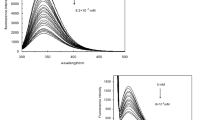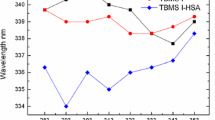Abstract
The interaction of trans-resveratrol (TRES) and bovine serum albumin (BSA) was investigated using fluorescence spectroscopy (FS) with Tachiya model. The binding number maximum of TRES was determined to be 8.86 at 293.15 K, 23.42 at 303.15 K and 33.94 at 313.15 K and the binding mechanism analyzed in detail. The apparent binding constants (K a) between TRES and BSA were 5.02 × 104 (293.15 K), 8.89 × 104 (303.15 K) and 1.60 × 105 L mol−1 (313.15 K), and the binding distances (r) between TRES and BSA were 2.44, 3.01, and 3.38 nm at 293.15, 303.15, and 313.15 K, respectively. The addition of TRES to BSA solution leads to the enhancement in RLS intensity, exhibiting the formation of the aggregate in solution. The negative entropy change and enthalpy change indicated that the interaction of TRES and BSA was driven mainly by van der Waals interactions and hydrogen bonds. The process of binding was a spontaneous process in which Gibbs free energy change was negative.







Similar content being viewed by others
References
Xiang GH, Tong CL, Lin HZ (2007) Nitroaniline Isomers Interaction with Bovine Serum Albumin and Toxicological Implications. J Fluoresc 17:512–521
Soares S, Mateus N, Freitas V (2007) Interaction of Different Polyphenols with Bovine Serum Albumin (BSA) and Human Salivary r-Amylase (HSA) by Fluorescence Quenching. J Agric Food Chem 55:6726–6735
Xiao JB, Shi J, Cao H, Wu SD, Ren FL, Xu M (2007) Analysis of binding interaction between puerarin and bovine serum albumin by multi-spectroscopic method. J Pharmaceut Biomed 45:609–615
Ran D, Wu X, Zheng J, Yang J, Zhou H, Zhang M, Tang Y (2007) Study on the interaction between florasulam and bovine serum albumin. J Fluoresc 17:721–726
Cui FL, Wang JL, Cui YR, Li JP (2006) Fluorescent investigation of the interactions between N-(p-chlorophenyl)-N′-(1-naphthyl) thiourea and serum albumin: synchronous fluorescence determination of serum albumin. Anal Chim Acta 571:175–183
Shang L, Jiang X, Dong S (2006) In vitro study on the binding of neutral red to bovine serum albumin by molecular spectroscopy. J Photochem Photobiol A 184:93–97
Bose B, Dube A (2006) Interaction of Chlorin p6 with bovine serum albumin and photodynamic oxidation of protein. J Photochem Photobiol B 85:49–55
Zhou N, Liang YZ, Wang P (2007) 18b-Glycyrrhetinic acid interaction with bovine serum albumin. J Photochem Photobiol A 185:271–276
Hu YJ, Liu Y, Zhao RM, Dong JX, Qu SS (2006) Spectroscopic studies on the interaction between methylene blue and bovine serum albumin. J Photochem Photobiol A 179:324–329
Wang YP, Wei YL, Dong C (2006) Study on the interaction of 3,3-bis(4-hydroxy-1-naphthyl)-phthalide with bovine serum albumin by fluorescence spectroscopy. J Photochem Photobiol A 177:6–11
Cao H, Xiao JB, Xu M (2006) Evaluation of new selective molecularly imprinted polymers for the extraction of reveratrol from Polygonum cuspidatum. Macromolecular Res 14:324–330
Maron DJ (2004) Flavonoids for reduction of atherosclerotic risk. Curr Atheroscler Rep 6:73–78
Baur JA, Sinclair DA (2006) Therapeutic potential of resveratrol: the in vivo evidence. Nat Rev Drug Discov 5:493–506
Das S, Tosaki A, Bagchi D, Maulik N, Das DK (2006) Potentiation of a survival signal in the ischemic heart by resveratrol through p38 mitogen-activated protein kinase/mitogen- and stress-activated protein kinase 1/cAMP response element-binding protein signaling. J Pharmacol Exp Ther 317:980–988
Fukuda S, Kaga S, Zhan L, Bagchi D, Das DK, Bertelli A (2006) Resveratrol ameliorates myocardial damage by inducing vascular endothelial growth fantorangiogenesis and tyrosine kinase receptor Flk-1. Cell Biochem Biophys 44:43–49
Raval AP, Dave KR, Perez-Pinzon MA (2006) Resveratrol mimics ischemic preconditioning in the brain. J Cereb Blood Flow Metab 26:1141–1147
Kumar A, Kaundal RK, Iyer S, Sharma SS (2007) Effects of resveratrol on nerve functions, oxidative stress and DNA fragmentation in experimental diabetic neuropathy. Life Sci 80:1236–1244
Tachiya M (1982) Kinetics of quenching of luminescent probes in micellar systems II. J Chem Phys 76:340–348
Horrocks WD, Collier WE (1981) Lanthanide ion luminescence probes. Measurement of distance between intrinsic protein fluorophores and bound metal ions: quantitation of energy transfer between tryptophan and terbium(III) or europium(III) in the calcium-binding protein parvalbumin. J Am Chem Soc 103:2856–2862
Förster T (1965) In: Sinanoglu O (ed) Modern quantum chemistry. vol. 3. Academic, New York, pp 93–137
Wang C, Wu QH, Wang Z, Zhao J (2006) Study of the interaction of carbamazepine with bovine serum albumin by fluorescence quenching method. Anal Sci 22:435–438
Ross PD, Subramanian S (1981) Thermodynamics of protein association reaction: forces contribution to stability. Biochemistry 20:3096–3102
Timaseff SN (1972) Proteins of biological fluids. Pergamon, Oxford, pp 511–519, 45
Liu ZD, Huang CZ, Li YF, Long YF (2006) Enhanced plasmon resonance light scattering signals of colloidal gold resulted from its interactions with organic small molecules using captopril as an example. Anal Chim Acta 577:244–249
Xiao JB, Yang CS, Ren FL, Jiang XY, Xu M (2007) Rapid determination of ciprofloxacin lactate in drugs by Rayleigh light scattering technique. Meas Sci Technol 18:859–866
Xiao JB, Chen JW, Ren FL, Yang CS, Xu M (2007) Use of 3-(4, 5-dimethylthiazol-2-yl)-2, 5-diphenyl tetrazolium bromide for rapid detection of methicillin-resistant Staphylococcus aureus by resonance light scattering. Anal Chim Acta 589:186–191
Chen JW, Yang CS, Ren FL, Xiao JB, Xu M (2007) Highly sensitive determination of chloride ion in serum using Rayleigh light scattering technique. Meas Sci Technol 18:2043–2047
Chen ZG, Liu JB, Han YL, Zhu L (2006) A novel histidine assay using tetraphenylporphyrin manganese (III) chloride as a molecular recognition probe by resonance light scattering technique. Anal Chim Acta 570:109–115
Acknowledgments
The authors are grateful for financial supported by National Natural Science Foundation of China (grant No. 20776162 and 20775092).
Author information
Authors and Affiliations
Corresponding authors
Rights and permissions
About this article
Cite this article
Xiao, J.B., Chen, X.Q., Jiang, X.Y. et al. Probing the Interaction of Trans-resveratrol with Bovine Serum Albumin: A Fluorescence Quenching Study with Tachiya Model. J Fluoresc 18, 671–678 (2008). https://doi.org/10.1007/s10895-008-0346-x
Received:
Accepted:
Published:
Issue Date:
DOI: https://doi.org/10.1007/s10895-008-0346-x




